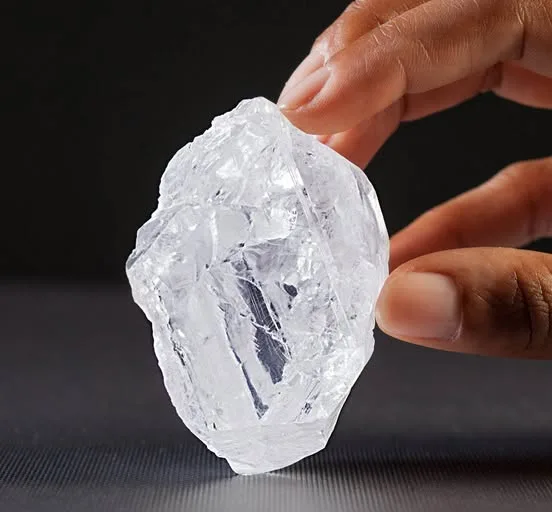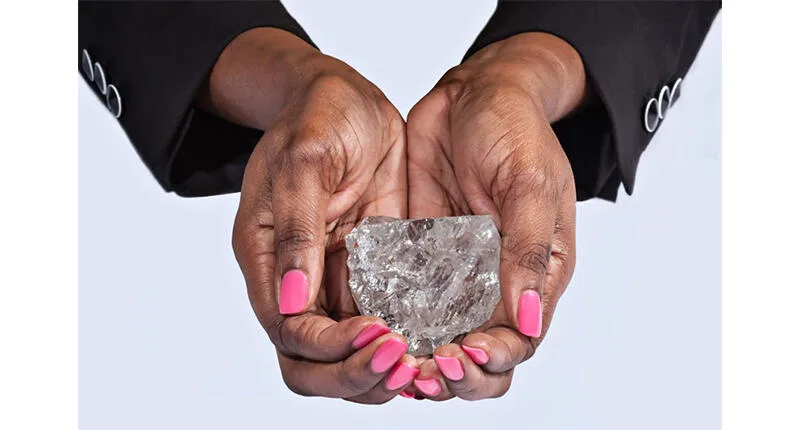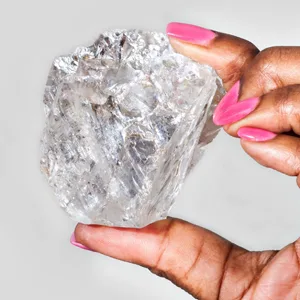Lesedi La Rona Diamond
A Glimmer of History in the Kalahari Sand

In the world of geology, history, and luxury, few events capture the imagination like the discovery of a truly colossal, one-of-a-kind gemstone. On November 16, 2015, the mining world held its breath as a monumental find was pulled from the earth: the Lesedi La Rona Diamond.
Unearthed from the prolific Karowe mine in Botswana by the Lucara Diamond Corp, this incredible specimen weighed an astonishing 1,109 carats (initially reported as 1,111 carats, approximately 222 grams). Instantly, it claimed its place as one of the largest diamonds ever found in human history, second only to the legendary 3,106.75-carat Cullinan Diamond.
Its very name, Lesedi La Rona, a phrase from Botswana’s Tswana language meaning “Our Light,” reflects the profound importance of this discovery not just to the diamond industry, but to the nation that yielded it. More than just a stone, it became a symbol of national pride, a geological miracle, and a beacon for the potential held within the ancient grounds of Southern Africa. Its immense size—comparable to that of a tennis ball—its extraordinary Type IIa purity, and its challenging journey to market all contribute to the enduring legend of this magnificent rough diamond.
This article delves deep into the full saga of the Lesedi La Rona: its incredible, technologically-assisted discovery, its historical context among the world’s most precious gemstones, the unprecedented and dramatic journey of its public and private sales, and the ultimate, masterful work of transformation by Graff Diamonds that cemented its legacy in the annals of luxury and gemology.
I. The Discovery: A Miracle at the Karowe Mine

The Karowe mine in Botswana, owned by the Canadian-based company Lucara Diamond Corp, has quickly established itself as one of the world’s premier sources for large, high-quality diamonds. Located in the Letlhakane region, the mine’s kimberlite pipe, known as AK6, has an unprecedented track record of yielding +100-carat stones, a feat largely attributed to its innovative processing technology. The Lesedi La Rona was discovered in the Karowe mine’s rich South Lobe.
A. The Technology Behind the Find: XRT Sorting
The retrieval of the Lesedi La Rona was a testament to modern, large-scale mining innovation. The colossal stone was simply too large and heavy to be processed safely through the standard automated sorting equipment designed for smaller diamonds. To ensure the integrity of the most valuable, rare gems, Lucara had implemented Large Diamond Recovery (LDR) technology, specifically advanced X-Ray Transmission (XRT) sorters.
The XRT machine revolutionized the process. It works by detecting the dense carbon structure of a diamond within the stream of crushed rock and gravel. When the diamond passes through, its structure is instantly recognized, triggering a blast of air jets that divert the stone into a separate recovery chute. This system was designed to prevent the breakage that has historically damaged massive rough diamonds, guaranteeing the 1,109-carat marvel, measuring 65 mm x 56 mm x 40 mm, was safely recovered intact.
The find was so significant that, within a 72-hour period of the Lesedi La Rona’s announcement, the Karowe mine also yielded the 813-carat Constellation and a 374-carat stone. Later analysis confirmed that this 374-carat specimen was, in fact, a fractured piece of the Lesedi La Rona itself, meaning the original diamond may have weighed close to 1,500 carats before fracturing—a staggering thought.
B. The Geological Significance: A Type IIa Masterpiece

The magnitude of the Lesedi La Rona is only half its value; its extraordinary purity is the other. The diamond is classified as a Type IIa diamond, the most coveted and purest type, a rare designation that applies to less than 2% of all mined diamonds globally.
- Chemical Composition: Type IIa diamonds are essentially pure carbon, containing little to no nitrogen atoms in their crystal lattice. This is crucial because nitrogen is the impurity that causes the yellowish or brownish tint often seen in lower-grade diamonds.
- Aged Perfection: This chemical purity results in extraordinary optical transparency, often described as water-clear or colorless. The Lesedi La Rona, with its high-quality, colorless/white grade, is estimated to be over 2.5 billion years old, a perfect crystalline structure preserved across epochs. Its size and purity together promised the potential for the largest, finest polished diamond in human history.
II. A Place Among Giants: Comparing the Lesedi La Rona to Historic Diamonds
The 1,109-carat Lesedi La Rona immediately secured its position in an exclusive, tiny club of gemstones. It stands as the second-largest gem-quality rough diamond ever recovered, and the largest discovered in over a century. To truly appreciate its scale, it must be measured against the historical giants.
A. The King: The Cullinan Diamond
The undisputed ruler of all rough diamonds remains the Cullinan Diamond. Discovered in South Africa in 1905, the Cullinan weighed a phenomenal 3,106.75 carats—nearly triple the size of the Lesedi La Rona. It was famously cut into 105 individual diamonds, most notably the Great Star of Africa (530.20 carats) and the Lesser Star of Africa (317.40 carats), which are now the centerpieces of the British Crown Jewels. While the Lesedi La Rona is smaller, its 2015 discovery ended a 110-year drought for a gem-quality diamond exceeding 1,000 carats, solidifying its status as the most important diamond find of the modern era.
B. The Modern Mega-Stones: Sewelô and Constellation
The Lesedi La Rona’s legacy is enhanced by the extraordinary company it keeps from its very own source. The Karowe mine has continued to yield +1,000-carat marvels, further establishing its geological uniqueness:
- The Sewelô Diamond (1,758 carats): Discovered in 2019, the Sewelô surpassed the Lesedi La Rona in raw carat weight, making it the second-largest rough diamond in history. However, the Sewelô is described as “near gem-quality” due to a layer of black carbon coating the stone, a feature that distinguishes it from the Lesedi La Rona’s superior Type IIa purity.
- The Constellation Diamond (813 carats): Found in the same week as the Lesedi La Rona, The Constellation sold for a record $63.1 million in 2016. Its high per-carat price demonstrated the market’s high valuation for Karowe’s large, high-quality stones and provided the initial financial benchmark that Lucara attempted to leverage.
The remarkable consistency of these colossal discoveries underscores Botswana’s critical role in the global supply of exceptional diamonds and positions the Lesedi La Rona as the catalyst for this modern-day, high-carat diamond rush.
III. The Unprecedented Journey to Sale: A New Approach to Rough Diamond Auction
The sale of a diamond this size is traditionally a quiet, private negotiation between a mining company and a handful of experienced dealers. Lucara Diamond, however, chose a different, high-stakes path: a dramatic, public auction on a world stage, betting on the diamond’s celebrity status.
A. The Sotheby’s Auction: A Gambler’s Risk and Public Failure
On June 29, 2016, the Lesedi La Rona was the focus of a historic, stand-alone auction at Sotheby’s London. Lucara CEO William Lamb justified the controversial move by arguing that the diamond’s unique status would attract affluent private collectors from outside the traditional diamond trade. The global media hype was immense, with conservative pre-sale estimates placing the stone’s market value at over $70 million.
The event proved to be a high-profile commercial failure. Bidding for the enormous gem opened at $50 million and proceeded slowly, stalling at $61 million. The final bid failed to meet the undisclosed reserve price, and the diamond was officially declared unsold. This event sent ripples through the industry. The consensus was that Lucara’s strategy underestimated the complexity and risk associated with cutting such a stone, a risk that only established diamantaire houses were equipped to properly underwrite.
B. The Final, Private Transaction: Graff Steps In
Despite the public setback, the diamond’s story was far from over. After over a year of intense private negotiations, the Lesedi La Rona found its true custodian. In September 2017, the renowned British multinational jeweler Graff Diamonds announced its acquisition of the stone for $53 million (USD).
This purchase was critical for several reasons. Laurence Graff, the legendary founder of Graff Diamonds, was uniquely positioned to acquire the stone, as he had already purchased the 374-carat fractured piece for $17.5 million in 2016. The $53 million acquisition reunited the “sibling” stones, allowing Graff’s team to study the combined crystal structure and predict the full potential of the Lesedi La Rona. While the final price was lower than the auction’s top bid, Graff’s unparalleled expertise in handling colossal, high-risk rough diamonds made him the ideal partner to unlock its ultimate brilliance. The purchase affirmed the need for deep, specialized knowledge when dealing with stones of this size and complexity.
IV. The Artistic Transformation: Graff Diamonds and the Genesis of the Graff Lesedi La Rona
With the world watching, the true challenge began for Laurence Graff and his team of master cutters. The cutting of a rough diamond of this size is a moment of immense pressure, where centuries of expertise, millions in capital, and reputation hang on a single, precise plan. Graff’s philosophy, “The stone will tell us its story,” guided the intricate, 18-month-long transformation process.
A. The Planning and Pioneering Technology
The physical size of the Lesedi La Rona presented an immediate, unique technical hurdle. The stone was simply too large for Graff’s existing scanning and analysis equipment, which is used to map a rough stone’s internal inclusions, stress points, and potential cleavage planes.
To overcome this, Graff’s team was forced to custom-build a new scanner with specialized imaging software capable of probing the vast expanses of the 1,109-carat crystal. Initial technological analysis suggested that cutting a single, flawless polished diamond of 300 carats was impossible due to the stone’s internal flaws and composition. However, Laurence Graff was adamant that the historic 300-carat milestone could and should be achieved. Following months of meticulous laser-mapping, the team identified the exact internal structure, enabling them to plot a revolutionary cutting plan that maximized both the size and the exceptional D-color and clarity.
B. The Final Collection: A Constellation of Record-Breaking Gems
The transformation resulted in one of the most stunning diamond collections in modern history. The Lesedi La Rona yielded a total of 67 individual polished diamonds, each one laser-inscribed with the moniker “Graff Lesedi La Rona” and its unique GIA number. This inscription serves as a permanent, verifiable link to the mother stone, preserving its provenance.
The undisputed star of this collection is the colossal 302.37-carat Graff Lesedi La Rona. This final, magnificent jewel achieved multiple world records upon its reveal in 2019:
- The World’s Largest Square Emerald Cut Diamond: A spectacular feat of geometry and cutting precision.
- The Largest Highest Colour, Highest Clarity Diamond Ever Certified by the GIA (Gemological Institute of America): Its superlative D color (totally colorless) and exceptional clarity cement its status as a masterpiece of both nature and craftsmanship.
The remaining 66 “satellite” diamonds range in size from under a carat to in excess of 26 carats, all sharing the same superlative color and clarity characteristics of the main stone. The combined weight and quality of the gems produced from a single rough stone is an overwhelming testament to the ingenuity and artisanal skill of the Graff team.
V. The Enduring Legacy: Impact on Botswana and the Diamond Market
The significance of the Lesedi La Rona stretches far beyond the cutting room floor and the luxury display cases. Its story has a profound and lasting impact on the nation of Botswana and the global diamond trade.
A. Economic and National Pride in Botswana
The name, “Our Light,” is a powerful symbol of national pride. The diamond industry is a crucial cornerstone of the Botswanan economy, and the consistent recovery of world-class stones from the Karowe mine, which means “precious stone” in the local language, reinforces the country’s reputation as a reliable and high-quality source of gems. Lucara Diamond’s agreement with the Botswanan government, which ensures the nation benefits directly from its mineral wealth, allows the proceeds from a find like the Lesedi La Rona to directly support infrastructure, education, and social programs, effectively transforming a geological miracle into tangible economic development for its people.
B. Redefining the Ultra-Luxury Rough Market
The saga of the Lesedi La Rona—from the XRT recovery to the dramatic public auction failure and the eventual private sale—has provided invaluable lessons to the diamond market. It highlighted the profound technical difficulty and financial risk associated with stones over 1,000 carats, but also cemented a new paradigm: that for the rarest stones, a private buyer like Laurence Graff who has the unparalleled expertise to maximize its potential will ultimately pay a premium.
The diamond redefined the ultra-high-end market for colossal rough stones and put the spotlight firmly on the Karowe mine as the world’s most exciting source of large, Type IIa material. The stone’s journey underscores a fundamental truth in the luxury world: a diamond’s ultimate value is a perfect blend of its raw carat weight, its exceptional quality, and the story of the human ingenuity required to transform it from a humble rough stone into a record-breaking masterpiece.
Conclusion: “Our Light” Shines On
The Lesedi La Rona is more than just an 1,109-carat rough diamond; it is a geological ambassador, a symbol of Botswanan mineral wealth, and a triumph of human artistry. Its journey began billions of years ago in the Earth’s mantle, traveled through the ancient kimberlite pipe of the Karowe mine, and culminated in a historic collection of polished jewels by Graff.
From a tennis-ball-sized, unyielding rough stone, it was transformed into the 302.37-carat Graff Lesedi La Rona, the largest highest color, highest clarity diamond ever certified by the GIA. The stone’s enduring legacy is a story of incredible odds: the miracle of its recovery, the gamble of its auction, the faith of its buyer, and the extraordinary skill of the cutters who unveiled the dazzling brilliance hidden within. The Lesedi La Rona remains “Our Light,” a shining, permanent marker in the continuous history of magnificent diamonds and a testament to the inexhaustible wonders of the Earth.

Leave a Reply